Perfect Competition and Monopole: Basic Characteristics of Perfect Competition
Added on 2023-04-22
22 Pages4145 Words70 Views
Running head: ECONOMICS FOR MANAGERS
Economics for Managers
Name of the Student
Name of the University
Course ID
Economics for Managers
Name of the Student
Name of the University
Course ID
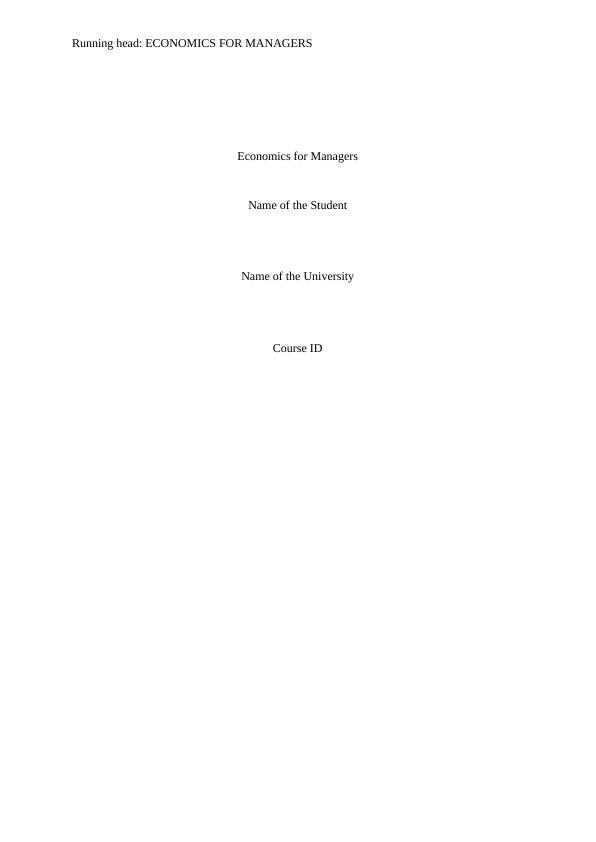
1ECONOMICS FOR MANAGERS
Question a
Perfect competition and monopoly: Basic characteristics
Perfect competition
Perfect competition signifies a form of market where a considerable large group of
buyers and sellers compete in the market. Sellers compete in the market in terms of selling an
identical product. Some basic characteristics of perfectly competitive market gives as
follows.
Number of buyers and sellers in the market
In the market, there are large number of sellers. Various sellers in the market compete
with each other. Number of buyers in the market are also relatively large. Due to presence of
a significantly large number of buyers and sellers, each has only a small market share and
therefore, does not have significant power to influence the marketing decision.
Nature of product sold
All firms in the market engage in selling similar or identical products (Waldman &
Jensen, 2016). Products sold in the market are perfect substitutes.
Entry barriers
In the competitive market, firms can freely enter or leave the industry. The industry
experience entry of new firms if there is more than normal profit in the market. Existing firms
leave the industry if they suffer economic loss.
Market power
Neither buyers nor sellers have any market powers. Buyers and sellers have to accept
the outcome determined by the free market forces of supply and demand.
Question a
Perfect competition and monopoly: Basic characteristics
Perfect competition
Perfect competition signifies a form of market where a considerable large group of
buyers and sellers compete in the market. Sellers compete in the market in terms of selling an
identical product. Some basic characteristics of perfectly competitive market gives as
follows.
Number of buyers and sellers in the market
In the market, there are large number of sellers. Various sellers in the market compete
with each other. Number of buyers in the market are also relatively large. Due to presence of
a significantly large number of buyers and sellers, each has only a small market share and
therefore, does not have significant power to influence the marketing decision.
Nature of product sold
All firms in the market engage in selling similar or identical products (Waldman &
Jensen, 2016). Products sold in the market are perfect substitutes.
Entry barriers
In the competitive market, firms can freely enter or leave the industry. The industry
experience entry of new firms if there is more than normal profit in the market. Existing firms
leave the industry if they suffer economic loss.
Market power
Neither buyers nor sellers have any market powers. Buyers and sellers have to accept
the outcome determined by the free market forces of supply and demand.
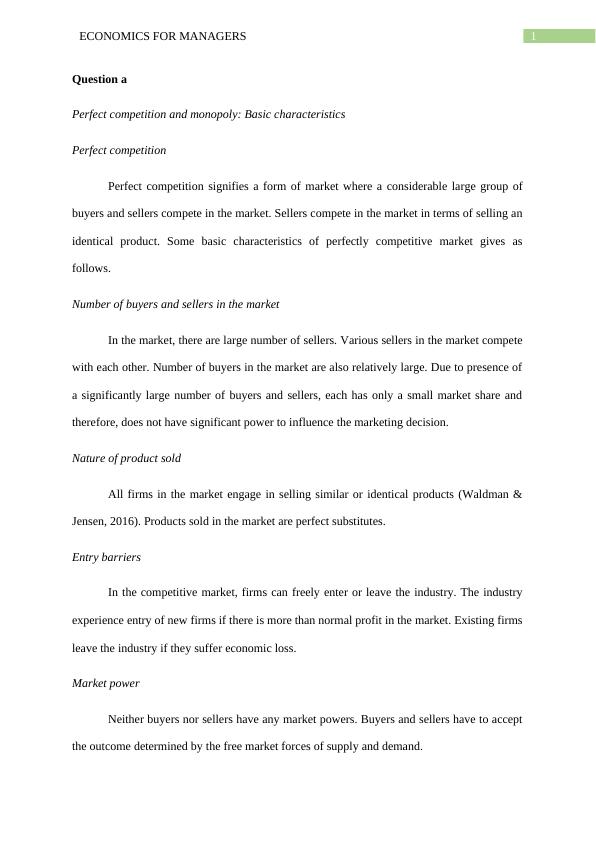
2ECONOMICS FOR MANAGERS
Monopoly
The word monopoly can be separated into two word ‘Mono’ and ‘Poly’. The word
‘Mono’ stands for single while ‘Poly’ stands for control. Monopoly thus refers to a market
situation having only one seller of the commodity in the market (Carlton & Perloff, 2015)
The basic features of monopoly market are given below.
One seller and large group of buyers
Monopolist firm is the single firm. It represents the industry as well. Numbers of
buyers in the market however are assumed to be considerably large. As single firm serves the
large group of buyers, the monopoly firm enjoys significant market power.
Nature of product
Product sold in the monopoly market usually does not have any close substitutes. The
unique product sold by the monopolist further increases market power.
Entry barriers
Like competitive industry, new firms cannot enter the monopoly market freely
(Karier, 2016). There are either legal or natural barriers to the entry of new firms.
Market power
The monopolist firm possesses maximum market power. Monopoly controls the
complete supply in the market. Group of buyers is generally large giving the single firm
maximum market power. Unlike competitive industry, where firms are price takers, the
monopoly firm is price maker.
Short run profit and losses in monopoly and perfect competition
Perfect competition
Monopoly
The word monopoly can be separated into two word ‘Mono’ and ‘Poly’. The word
‘Mono’ stands for single while ‘Poly’ stands for control. Monopoly thus refers to a market
situation having only one seller of the commodity in the market (Carlton & Perloff, 2015)
The basic features of monopoly market are given below.
One seller and large group of buyers
Monopolist firm is the single firm. It represents the industry as well. Numbers of
buyers in the market however are assumed to be considerably large. As single firm serves the
large group of buyers, the monopoly firm enjoys significant market power.
Nature of product
Product sold in the monopoly market usually does not have any close substitutes. The
unique product sold by the monopolist further increases market power.
Entry barriers
Like competitive industry, new firms cannot enter the monopoly market freely
(Karier, 2016). There are either legal or natural barriers to the entry of new firms.
Market power
The monopolist firm possesses maximum market power. Monopoly controls the
complete supply in the market. Group of buyers is generally large giving the single firm
maximum market power. Unlike competitive industry, where firms are price takers, the
monopoly firm is price maker.
Short run profit and losses in monopoly and perfect competition
Perfect competition
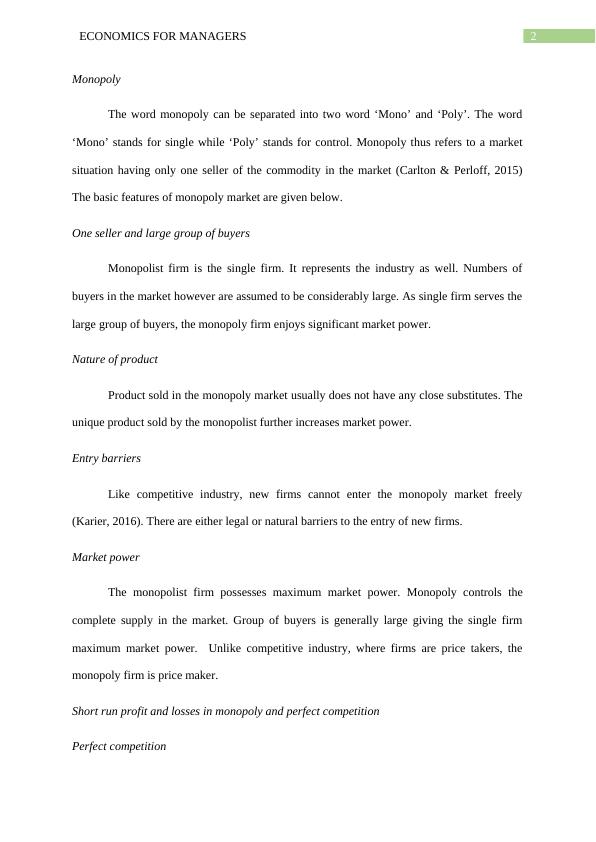
3ECONOMICS FOR MANAGERS
Following large number of buyers and sellers in the market, the market demand curve
perfectly elastic for competitive firms. A horizontal line parallel to the output axis represents
the perfectly elastic demand curve. Given that, competitive firms are price takers in the
market marginal revenue and average revenue both equal price (McKenzie & Lee, 2016).
Profit maximizing condition for firm requires marginal revenue and marginal cost are same.
In the competitive market, the profit maximizing condition implies price equals marginal
cost. Corresponding to this point, marginal cost goes through marginal revenue from below.
It is only in the short run where competitive firms can enjoy supernormal profit, loss or
normal profit. Firms earn supernormal profit is price is above the average cost. Firms incur
loss in situations where price is less than average cost. Firms earn only normal profit if price
is just the same as average cost.
Figure 1: Short run profit
Following large number of buyers and sellers in the market, the market demand curve
perfectly elastic for competitive firms. A horizontal line parallel to the output axis represents
the perfectly elastic demand curve. Given that, competitive firms are price takers in the
market marginal revenue and average revenue both equal price (McKenzie & Lee, 2016).
Profit maximizing condition for firm requires marginal revenue and marginal cost are same.
In the competitive market, the profit maximizing condition implies price equals marginal
cost. Corresponding to this point, marginal cost goes through marginal revenue from below.
It is only in the short run where competitive firms can enjoy supernormal profit, loss or
normal profit. Firms earn supernormal profit is price is above the average cost. Firms incur
loss in situations where price is less than average cost. Firms earn only normal profit if price
is just the same as average cost.
Figure 1: Short run profit
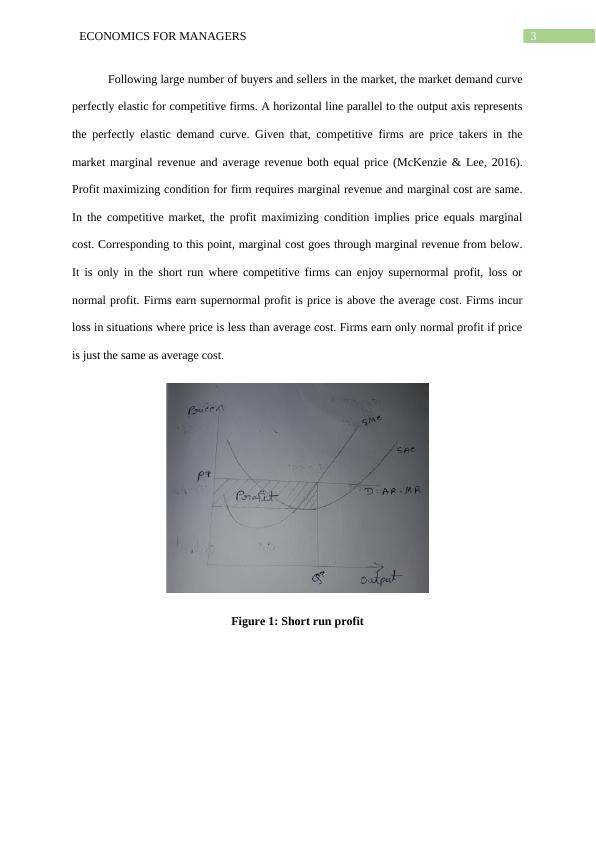
4ECONOMICS FOR MANAGERS
Figure 2: Short run loss
Figure 3: Short run normal profit
Monopoly
Given monopolist is the price maker in the market, the demand curve slopes
downward. The marginal revenue curve lies below the demand curve. The profit maximizing
condition of monopoly firm requires marginal cost to be equal to marginal revenue (Stiglitz
& Rosengard, 2015). At the equilibrium point, marginal cost and marginal revenue intersect
each other from below. Monopolist firm can enjoy profit above the normal level, normal
Figure 2: Short run loss
Figure 3: Short run normal profit
Monopoly
Given monopolist is the price maker in the market, the demand curve slopes
downward. The marginal revenue curve lies below the demand curve. The profit maximizing
condition of monopoly firm requires marginal cost to be equal to marginal revenue (Stiglitz
& Rosengard, 2015). At the equilibrium point, marginal cost and marginal revenue intersect
each other from below. Monopolist firm can enjoy profit above the normal level, normal
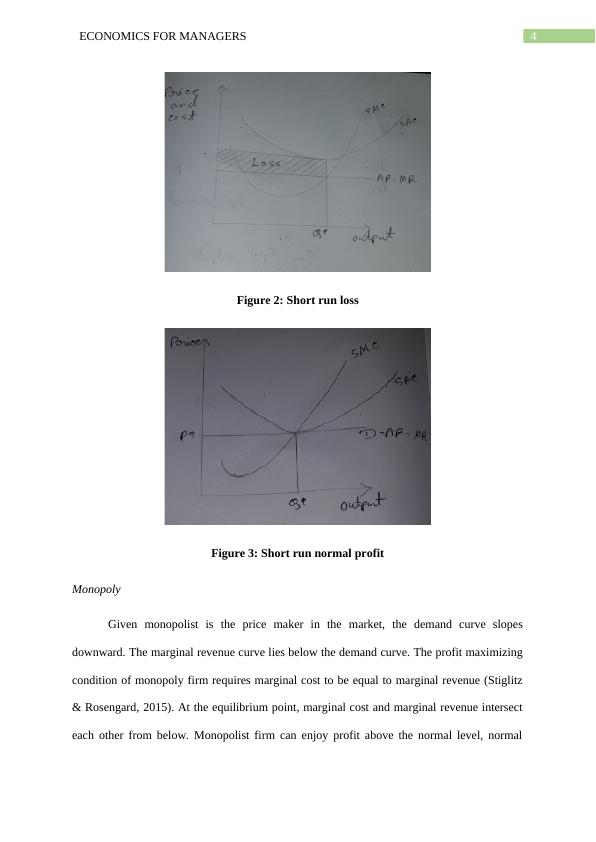
5ECONOMICS FOR MANAGERS
profit or suffer economic loss. The monopolist however most likely to earn above normal
profit.
Figure 4: Short run equilibrium under monopoly
Long run profit and losses in monopoly and perfect competition
Perfect competition
In the long run, adjustment in the competitive industry occurs in terms of entry or exit
of firms. Given no entry barriers, new firms freely enter the market if there is more than
normal profit. As new firms enter the industry, market supply increases. This shifts the
market supply curve to the right. The excess supply lowers market price and profit. Firms
leave the industry when they suffer from economic loss (Moulin, 2014) With exit of the
firms, industry supply reduces and the supply curve shifts to the left. This pushes up prices
and loss gradually recovered. The free entry and exit mechanism results in only normal profit
in the industry.
profit or suffer economic loss. The monopolist however most likely to earn above normal
profit.
Figure 4: Short run equilibrium under monopoly
Long run profit and losses in monopoly and perfect competition
Perfect competition
In the long run, adjustment in the competitive industry occurs in terms of entry or exit
of firms. Given no entry barriers, new firms freely enter the market if there is more than
normal profit. As new firms enter the industry, market supply increases. This shifts the
market supply curve to the right. The excess supply lowers market price and profit. Firms
leave the industry when they suffer from economic loss (Moulin, 2014) With exit of the
firms, industry supply reduces and the supply curve shifts to the left. This pushes up prices
and loss gradually recovered. The free entry and exit mechanism results in only normal profit
in the industry.

End of preview
Want to access all the pages? Upload your documents or become a member.
Related Documents
Characteristics of Perfect Competition and Monopoly Marketlg...
|19
|4154
|468
Economics for Managerslg...
|21
|3971
|408
Principles of Microeconomics Assignmentlg...
|13
|2832
|54
Types of Market Structure: Perfect Competition, Monopoly, Oligopoly, Monopolistic Competitionlg...
|19
|4224
|23
Economics for Managers: Perfect Competition, Monopoly, Oligopoly, and Australian Supermarket Industrylg...
|16
|4513
|222
Economics: Market Structures and Housing Affordability Crisislg...
|15
|3199
|335
